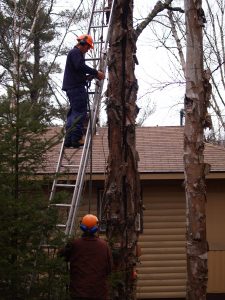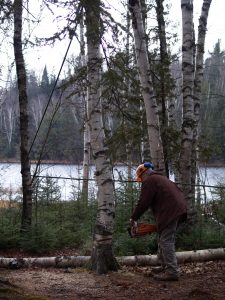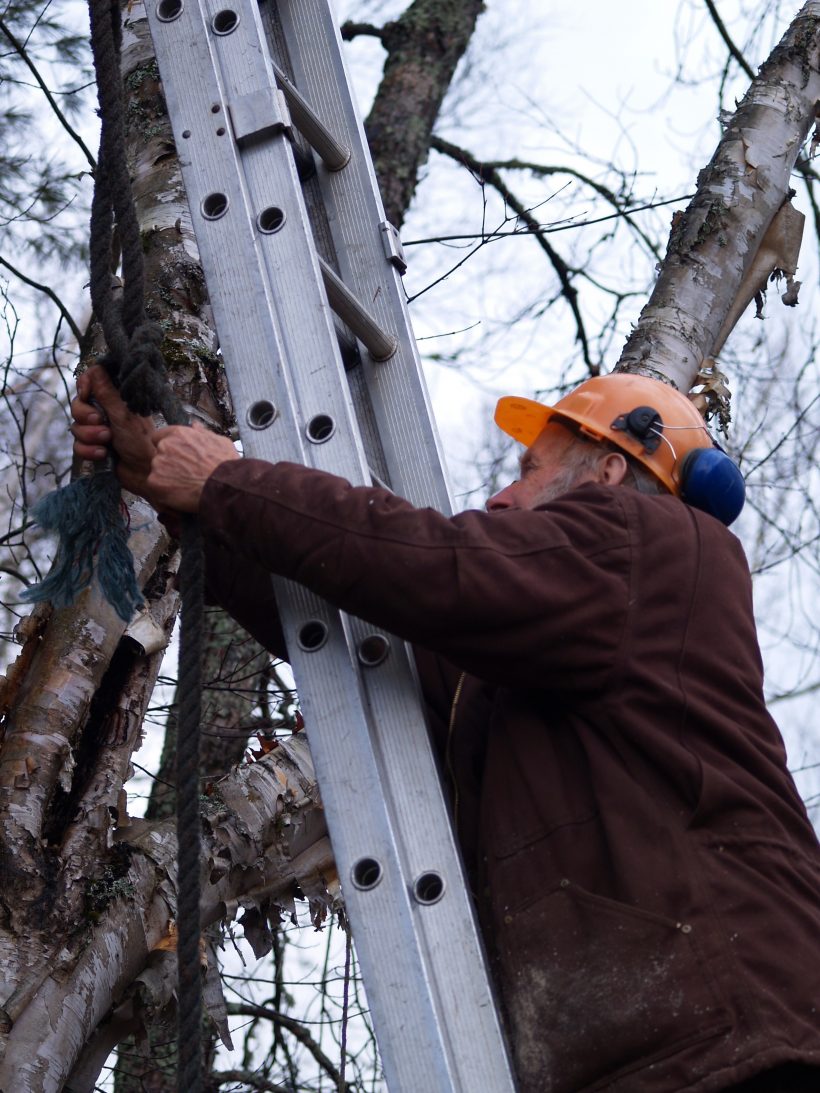DANGEROUS TREE REMOVAL
Safely used by respectful, knowledgeable individuals, chain saws can be useful tools. They make a good servant but a terrible master. An acquaintance who teaches chain saw safety was driving in to his hunt camp when he had to pass a mound of logs. Perched atop was a man wearing a bathing suit and flip-flops chain sawing his winter wood. “I had to stop and have a chat,” said my friend. “I don’t know if it did any good. He thanked me for my concern.”
I cut and split my own firewood for 30 years. When I started, a log truck load of logs cost $300. When I stopped a load was approaching $800.
Chain saws have my respect. My family bought me the safety hat and pants and I faithfully wear it all before setting out to cut up any wood. But when it comes to dangerous trees that is a challenge I leave to those who are experienced in such matters. For instance, now that I own the transmission line on my own property thanks to Hydro policy I am also responsible for keeping the line clear of dangerous trees. Dangerous because they could possibly take down my line and dangerous because we are dealing with hydro lines.
Hans Koster has been doing such work for over 30 years. Born in Amsterdam on January 30, 1935, Hans finished his formal schooling at the age of 14. “I always wanted to be a farmer,” he told me. So he hired on with a local farmer and learned to plough with horses. “They were harnessed so that one line directed them all,” he said. The appropriate signal transmitted through the line indicated to the horses whether they would go left (“Haw”), right (“Gee”) or stop (“Whoa.”) “Their training was the result of much repetition coupled with voice command.” The Belgians in Holland tended to be chunkier than the ones here in Canada.
One of Hans’ brothers emigrated to Canada in 1953. His mother, two sisters, two brothers and Hans emigrated in 1954. His father, a technical teacher, remained behind as his parents were separated. Why did they leave Holland?
Hans smiled. “I’ve been asked that a thousand times.”
They had endured the Nazi invasion and occupation of WW2 and the cold war between Russia and the allies was heating up. “We believed another war was inevitable and we wanted to avoid that.” Also, land was so expensive there would be no chance of owning your own farm. If land became available it went to family members.
Canada was advertising for immigrants with farming experience. Many workers were moving to jobs in the cities and farm workers were needed. Plus Canadians had help ed liberate Holland in WW2. “The Canadian troops gave us chocolate bars, the Royal family had connections to Canada and we were grateful to Canada.”
The Royal Connection
When WW2 broke out in the Netherlands May 1940, the Dutch Royal Family fled to London, England. Princess Juliana and her daughters Beatrix (to-day the current Queen) and Irene travelled to Ottawa and lived at Stornoway, to-day’s official residence of the Leader of the Opposition. Beatrix attended nursery and primary school at Rockcliffe Park Public School. On January 19, 1943, Princess Juliana gave birth to Margriet. The Canadian Government declared the maternity suite at the Ottawa Civic Hospital “extraterritorial” guaranteeing full Dutch citizenship for the newborn. Margriet was the first, and only, royal baby ever to be born in North America. This forged a bond between Canada and the Netherlands that has continued to this day. In appreciation Princess Juliana began the tradition of sending tulips to Ottawa, a highlight of the Tulip Festival.
Farming
The ads were somewhat misleading suggesting that immigrants could afford their own farm. Basically, Hans said, that was far fetched. “In some instances it was possible.” He explained that a family might afford a farm if the kids went to work off the farm and turned their wages over to their parents who ran the farm.
A Markham farmer sponsored Hans for one year. Hans stayed on for three in appreciation for the people “who sponsored me”. Then he worked in construction for a while. He married a Mennonite girl whose father later on sold his 100 acre farm for $50,000. “We couldn’t afford it,” he said. “Imagine what it would be worth to-day!” (It also was in Markham.) Instead, they moved to Fort Stewart in 1962 and bought 175 acres, half cleared with a new house on it for $5,500. Hans soon found that farming couldn’t provide enough income but in the first year he built a barn from cement blocks and people in the area took him to be a block layer and were soon hiring him to build for them. Then he began to work in the bush. He liked being outdoors and working with horses once again. Next he got a 100 acre bush lot to timber out and a friend, Wendell Bruce, suggested that he approach Hydro about clearing new hydro right of ways. In the meantime Hans learned about the various types of trees, how they responded to cutting and how to fell trees with 0% chance of accidentally taking out hydro lines or suffering personal Injury. “Whenever I try to learn I seek out the experts and ask lots of questions,” said Hans. When Hydro decided to look after its own right of ways Hans continued with his dangerous tree removal applying the laws of physics and geometry that he had learned from experience in the bush.

Hans breaks into smile as he recounts clients who hire him. “I ask them where they want me to drop the tree.” He provides choices and often they stand in disbelief as he drops it on the promised spot. Usually he uses ropes and pulleys but on occasion knowing the type of tree and how it reacts allows him to fell trees without any additional equipment. “How do you do it?” they ask somewhat astonished. Of course, he says, it took years of experience. There is no secret.
Hans enjoys the challenge and often in the quiet of the night when there are no distractions, laying in bed, and the answers to some very difficult problems come to him. It’s the subconscious at work. “You can’t force the answer,” he responded.
Hans does a few jobs in the winter. One client doesn’t want to damage his lawn. In other cases he needs a frozen lake to access the task. And what does this 76 year old dangerous tree removal expert do in his off time?
“I have been to Haiti 9 times in the last 3 years,” he said. He goes as part of a group called Haiti Missions.
As for retirement, suffice it to say that he’s not familiar with the word. 2011
Note: Hans passed during the Fall of 2023. As far as I know he continued to work until 2022, perhaps into 2023.

